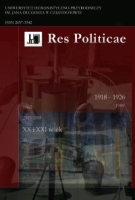The national philosophical anthropology of the third reich political elite ‒ selected aspects
Keywords:
anthropology, race, Germany, the Third Reich, the nation, „New Man”Abstract
From anthropological perspective, the appearance of the „New Man” resulted from externalization of
the National Socialism ideology. The image evolved from the political process taking place on the turn
of the nineteenth and the twentieth centuries in the Hohenzollern Empire, in the Weimar Republic, and
finally, in the Third Reich. This way, by promoting education of the new generations grounded in the
national philosophical anthropology, the Germans modified their own image. This modification concerned
the exceptional Arian features of the German national physiognomy. Thus, the characteristic type of
a human, which was exclusively attributed to German society, was formed. Ideologically the image of
this anthropological type influenced the hygienic approach of the nation and it contributed to evolution
of sterile genetic heritage. According to these anthropological directives the Homo Nordicus X Dinaricus
type was distinguished, which consequently, in its assumptions led to indication of the Nordic race, the
Nordids. From that point, a kind of breeding process of the „New Man” had been taking place, and it
resulted in creation of new National-Socialist identity. The concept of the New and, since then, also Political
Man was a clear evidence of this breeding process. The created ideal reflected ideological and educational
methodology of formation of the future nation’s elite. National Socialism constituted a fertile
ground for formation and exploitation of its potential. The cult of the body was a very significant aspect
of education, in which the German physiognomy was affiliated with the Nordic race. In other words, the
breeding process was conducted by forming the malleable model on the basis of an ideal design. The
typology of the Germans as athletic blue-eyed and blond-haired strongmen was based on the conviction
that the Nordic race was superior to other peoples of Europe. The purpose of this typology was not only
to determine the features of the race but also to build its aesthetic visual reception. In this respect, the
existence of the „New Man” was strongly determined by the reality of the 1933‒1945 period.


